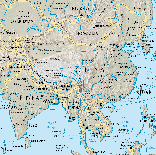In I got It!
The Raging River
The Sambatyon River leaves a mystery of its true location.
In the year 5608 (1847ce), a claim was put forward that the Sambatyon River, over which had been exiled the Ten Tribes by Shalmaneser king of Babylon, was to be found in China.
In the month of Tishrei, 5608, Reb Moshe Yafe, an emissary to the Far East and India, wrote a letter to Reb Yosef Shvartz, author of ‘Tvu’as ha’aretz’, in which he put forward this claim.
In the same year, on 28th Iyar, Reb Moshe of Calcutta, India, wrote that he had reliable information that the Sambatyon River was to be found in China. He had witnesses who related that, at a distance of two months’ travel from Gvongdong canton, a district in south China, there was a river that for six days of the week ejected stones and sand – and then rested on the seventh day.
In fact, we have a testimony from Roman times from Pliny the elder, that in Yehuda there was a river that flowed all week but on Shabbos was dry. There were those who associated this river with the Sambatyon, which, according to our sources, throws up stones and dirt all week, and rests on Shabbos. From this, its very name is derived – Sambatyon – from the Sabbath.
Other early sources, notably that of Eldad Hadani, a Jewish merchant in the 9th century, place the Sambatyon River in India. He related that he had found members of the tribe of Dan, one of the exiled ten tribes, and that their state was surrounded by a river which spewed out stones six days of the week, and only on the seventh day rested and flowed as a normal river.There exist more than eight versions of his account, and an analysis of them leads to the conclusion that the Sambatyon river is to be found in India.
Over the years, many explorers have attempted to find the location of the Sambatyon, some of whose accounts are more reliable than others. But none of the various explanations has led to a conclusive answer to this mysterious quest.







